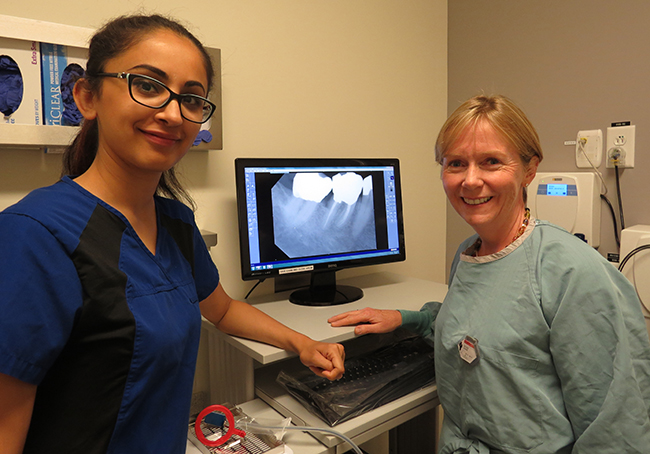
By teaching dental students to take better digital X-ray images, Univeristy of Alberta dental professor Anthea Senior aims to reduce the need for patients to be exposed to repeated doses of the low-level radiation.
Every day patients ask dentists if the X-rays they're taking are safe. And while dentists can reassure patients that digital X-rays use very low levels of radiation-even less radiation than their predecessor, conventional film-a careful placement technique to avoid re-exposures is still essential.
"There's a learning curve with digital X-ray equipment," said Anthea Senior, a clinical associate dentistry professor at the University of Alberta's School of Dentistry. "Because the placement of the digital sensor is different from film, more images can be required to see the areas that you need, which could render the benefits of the lower radiation to make the image moot."
After noticing the significant struggle dentistry students were having with the different techniques required to take digital X-rays, Senior developed an iBook training manual for classroom and clinic use in 2014.
"I wrote the manual to improve the quality of the original images and thus reduce the amount of images that need to be repeated, with the impetus to reduce the doses of radiation we are getting," she said.
Senior's original manual has been downloaded in institutions worldwide and her videos demonstrating digital techniques have had thousands of views. That's why, with business advice and licensing assistance from TEC Edmonton, Senior recently partnered with Dentsply Sirona to extend the manuals' use as a training resource for industry and practitioners. The updated manual with improved images and videos is expected to be released in the next few months.
How much radiation is too much?
So what is a safe amount of radiation? And how can we make sure we're not getting too much?
Generally, the total amount of radiation from conventional dental intraoral and extraoral imaging is less than one per cent of the overall amount of radiation we are exposed to annually from the environment. That said, because there is no safe threshold of a radiation dose below which there is no risk, the goal is always to minimize exposure by only taking X-rays when absolutely needed and to make sure the dose is kept as low as possible, said Senior.
The million-dollar question is, how much more radiation is the average Canadian exposed to when extra digital images are taken in the dentist's chair? Senior said that although individual exposure is very low, overall the dose to the population as a whole accumulates.
"Because millions of people get dental X-rays performed, the collective dose to the population is not insignificant," she said.
How many X-rays should I get?
"It is not a case of 'one size fits all' when deciding how often and what kind of dental X-rays you should have done," said Senior.
Deciding whether to prescribe an X-ray to help with a diagnosis is done on a case-by-case basis. The practitioner and patient consider when the last set of X-rays was taken, what the patient's disease rate and past dental history look like, and what is found during their dental examination, Senior said.
Intraoral images such as bitewings allow dentists to identify very early decay between teeth that can't be spotted any other way. Extraoral images, such as panoramic views, show less detail but allow larger areas of the teeth and jaws to be seen.
Bottom line
Dental X-rays are an incredibly useful tool that assist dentists in diagnosing and managing serious oral problems, said Senior.
"Have a conversation with your dentist before you have any X-rays taken to find out why they are necessary, and once you've had them taken, ask about what they are showing," Senior advised.